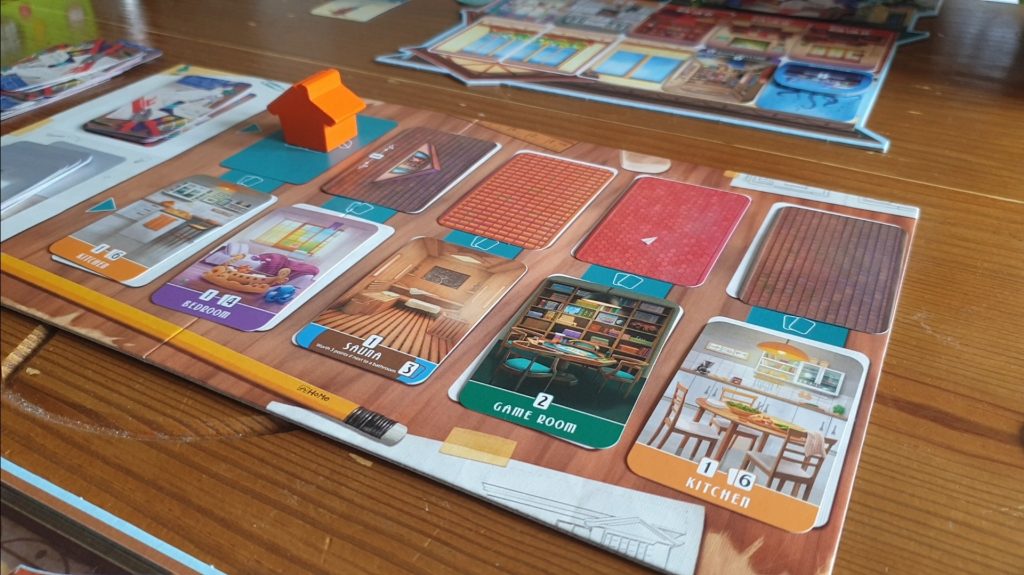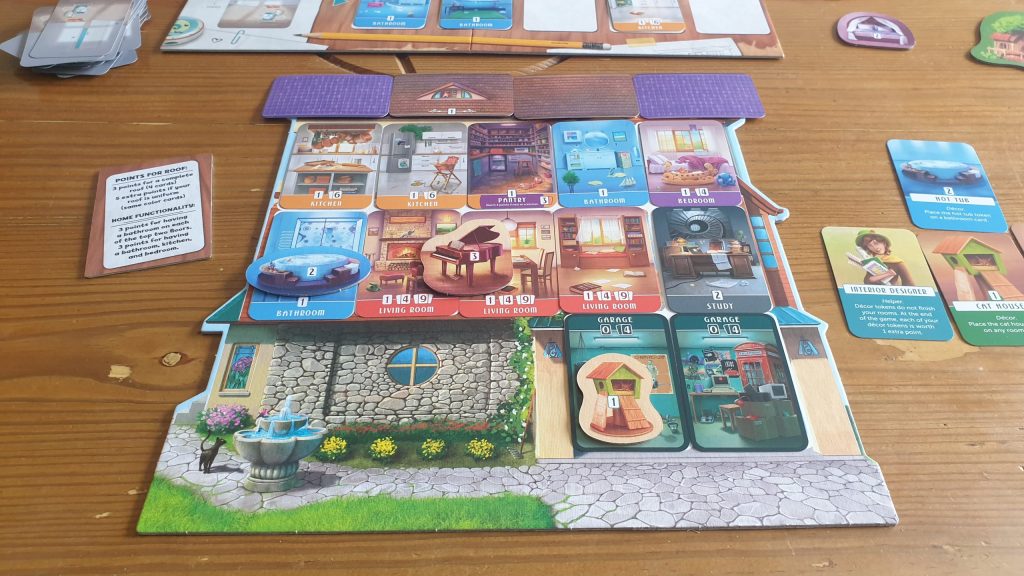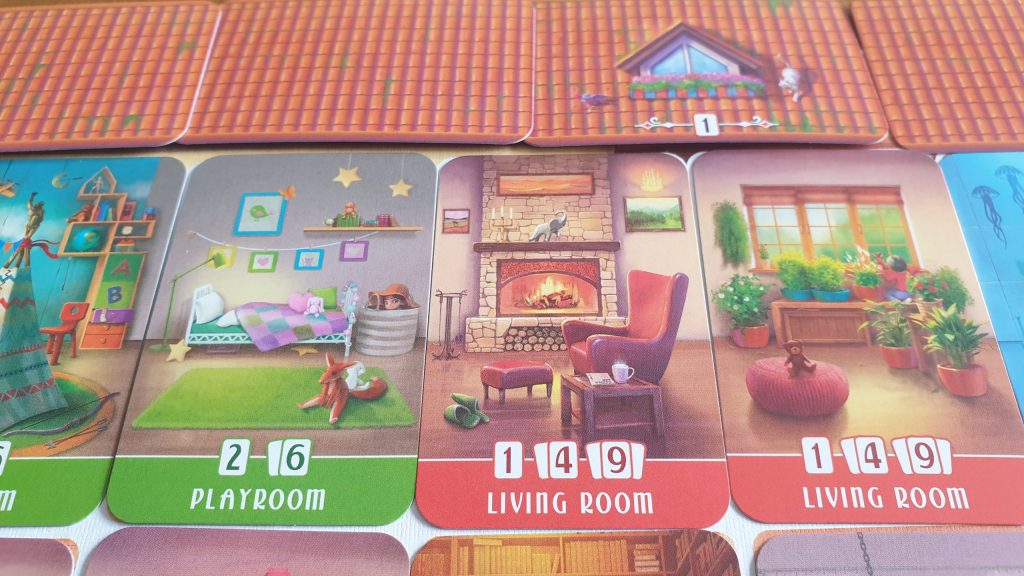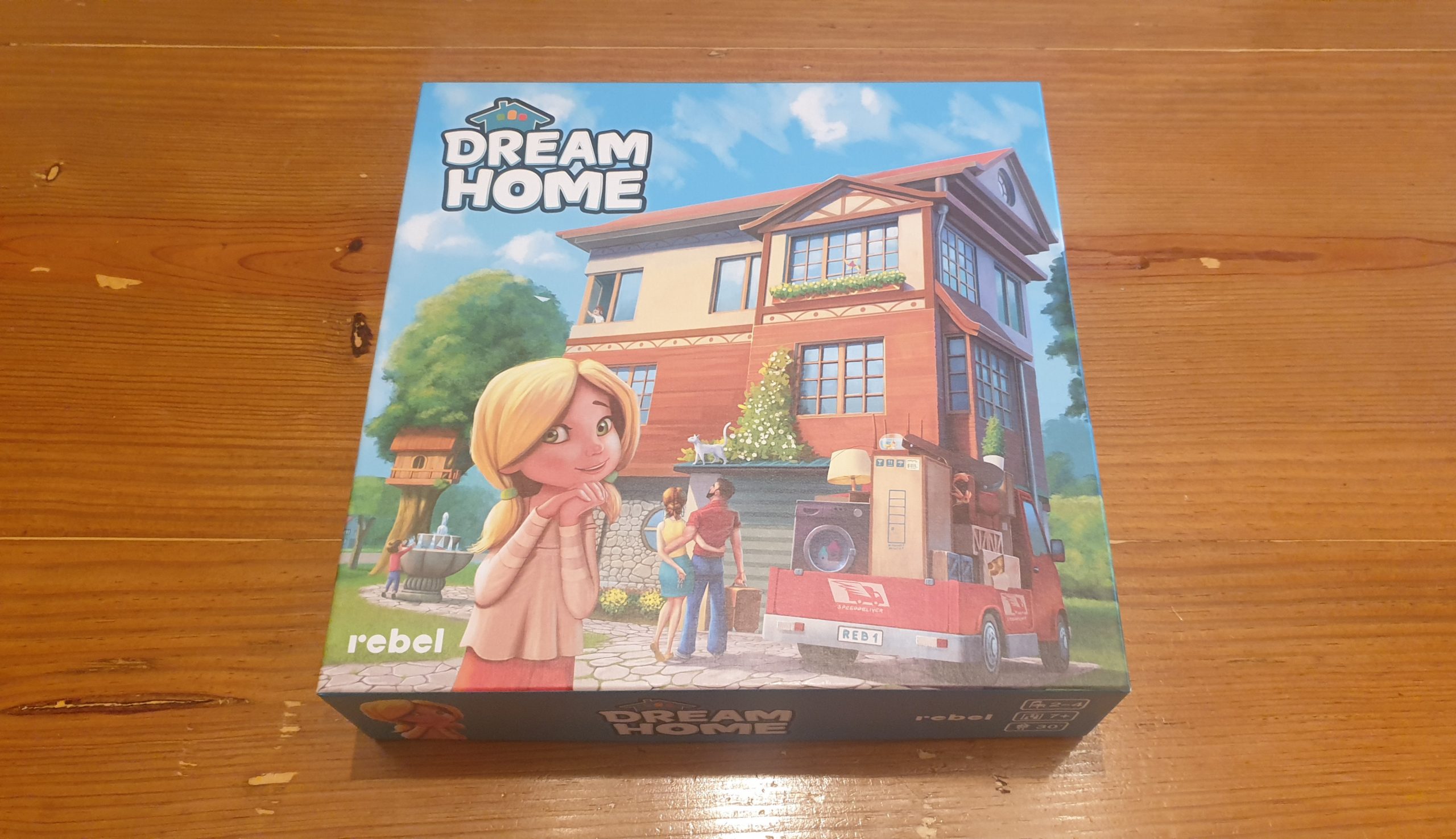Dream Home is a set collection board game from publisher Rebel, released originally back in 2016. Designed by Klemens Kalicki, featuring artwork from Bartłomiej Kordowski, the game sees 2 – 4 players draft room cards, obtain decorative items and hopefully have a complete roof for their home! Lasting around 25 minutes, players try to create their dream home, or at least one that fulfills the objectives. However, is this family game a dream to play? Let’s find out!
Each player takes an empty home board, which is full of spaces to add rooms to. A central market board is placed in the middle of the table, with shuffled room and resource decks placed separately on their denoted spaces. At the start of each round players turn over 5 room cards and 4 resource cards, creating pairs. The 5th resource is the first player marker, with the starting player each round only changing if someone claims this room and marker pair.
Starting with the first player, and going clockwise around the table, each player takes a pair of a room and a resource from the central board. The room must be instantly added to their personal house board. There are a few logical building limitations to work within. A room cannot be built over an empty room space, so initially only 3 spaces on the middle floor of the house and the 2 basement level spaces are available.

Players will often want to build the same type of room cards next to each other, as sets garner more points. However, players cannot extend a room if the set is already at its maximum size. For example, playrooms on their own score 2 points and they have a maximum size of 2. Building two next to each other scores 6 instead of the 4 for building them separately. This is then a completed set, so a third playroom cannot be built adjacent to them – with adjacency in Dream Home only being on the same floor. If a player doesn’t wish to build a specific room or cannot build one it is placed onto the player board in a room space facedown, signifying it is an empty room.
Alongside gaining a room card players will also get a resource each time. The most common are roof cards, which come in a variety of colours. These are saved facedown for a scoring opportunity at the end of the game, with a small area near the house’s porch to store them. Resource cards are also how players will get their hands on decorative items. These are cardboard tokens players add to specific rooms in their home – which finish a room as if the set were complete – to score the denoted points.
Other resource cards allow players to break some of the standard rules, or just help out. Scaffolding can be added to an empty space to allow a room to be built above it, with a room later being placed over the top of the scaffolding. Others allow the player to tweak the cards in the market before they take a pair, ignore decorative items when expanding rooms and even swapping rooms around at the end of the game.

Played out over 12 rounds every card in the deck will have been available at some point from the market. After the final round players can activate resources such as handymen or architects they collected during the game to utilize their powers. Players then score points across four main categories. Rooms score the points based on their sets, with decorative items in the rooms also scoring points. Players then get points if they have fulfilled the home functionality objectives, to have a bathroom on both upper floors and have a bathroom, bedroom and a kitchen, and depending on their roof cards. The winner is then the player that has the most combined points!
A memory aspect is added to the game via the roof scoring mini game. During the game the roof cards a player collects are placed facedown, and importantly cannot be checked. The roof scores 3 points if a player has 4 cards, though bonus points are awarded if all 4 cards are of the same colour. It sounds like an easy task to remember the colour of roof cards you’ve obtained. Yet, with many other cards catching your attention it is easy to forget; was it brown or purple tiles… Some players have got a bit frustrated by not being able to check what they’ve previously taken, though it is only a small element of the overall game.
Dream Home is an eye catching game, with bright colours used to make the room types easily differentiable. As you place room cards it’s almost as if players are seeing into the house with xray vision. In most games of this type the bathroom or living room cards would look identical. Not only is this not the case with Dream Home but the unique rooms merge together. This allows the homes to have their own quirky feel. While the cards are small, normally a pet peeve of mine, it makes sense in Dream Home as they have to fit next to each other on the player boards. The game also comes with an awesome insert, with a brick like pattern and ample room for all the cards and components – including the chunky first player marker.

There is a fair bit of admin to do between rounds when playing with only 2 players, and even at 3, as there is a rule of discarding cards. The full market of cards is filled out only for the starting player to have to choose a pair of cards to discard. Unfortunately, this drives a feeling of being unlucky. The starting player of a round has even more power, as they effectively have the opportunity to get rid of two columns that could have been good for the other player – by discarding one and taking the other. Whilst I doubt at a family level this would be done aggressively to screw over an opponent, there is the opportunity to be mean – which doesn’t quite fit with the rest of the game.
The replayability of Dream Home is hampered as there is no way to change up the home functionality objectives. The rule for having a bathroom on each floor for example gives some direction to the players to not solely aim for high point scoring rooms. If that objective changed each game it would help the experience stay fresh by making what the rooms were “worth” more dynamic. Four cardboard objective reminder tokens are included in the box, which is great for making sure everyone is informed. Though, those 4 could have been different objective tiles to play with over different games. Giving a similar vibe are the room decorations that add extra details to the created homes. Again though, what was available could have been varied from one game to the next to make individual games feel different.
Dream Home has a number of things going for it, which makes it a great introduction to modern board games for families. Undeniably the game looks stunning with the way the rooms merge and slowly become a full home. The turns are quick with simple choices from the market, with every turn feeling progressive towards completing the house – even if the optimal rooms were snapped up by others. The game plays consistently well at all player counts, though at higher player counts less admin per player occurs. There are a few special rooms to spice up the scoring. Still, the lack of more interesting combos and scoring opportunities which allows Dream Home to be family friendly, results in it slightly lacking for gamers. Perhaps the expansion could fix these issues to allow the game to be better for all, though as a base game it is on the simple side.
(Editor’s Note: Dream Home was provided to us by Asmodee for the review. The game is currently available from local board game stores, some of which are reopening! Find your local store here.)

